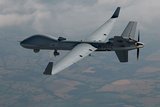Australian Herons achieve record flying hours
The fourth rotation (ROT 4) of Australia's Heron Remotely Piloted Aircraft (RPA) Detachment in Kandahar, Afghanistan, has set a unit record for monthly flying hours. Commanding Officer Heron RPA Detachment - ROT 4 Wing Commander Greg Wells said his personnel had achieved 475 hours during April.
"This exceeds the efforts of previous Heron rotations and means we have reached a point where we are able to achieve a significant amount of time on station providing an all-important ‘eye in the sky' for our troops," Wing Commander Wells said.
"One of the advantages of Heron is it can stay airborne for a very long time. We deliver enhanced situational awareness to our soldiers, which is vital in helping them achieve their mission on the ground."
"The success of Heron is a combination of both smart technology and people. A typical Heron mission involves a lot of work from a very small team of specialists, ranging from engineers to intelligence officers, imagery analysts and pilots."
The Heron team comprises 28 Australian and New Zealand Defence Force personnel. The tri-service unit has logged more than 4600 total flight hours since beginning operations in January last year.
Dubbed ‘Bluey' by the Australians, the Heron can fly for up to 24 hours and is a key asset in the conduct of intelligence, surveillance and reconnaissance missions in the Afghanistan theatre of operations. It helps to protect Australian and Coalition forces, as well as Afghan civilians, from insurgent activity, including the laying of improvised explosive devices.
Information collected by the Heron is analysed and processed in real time. This means the commander has the benefit of having eyes on a target to build a more accurate picture of the battlespace.
Heron are operated from a ground base, controlled by trained pilots and can withstand a range of weather conditions.
"Every suspicious activity we investigate and every improvised explosive device activity we identify is potentially a life saved," Wing Commander Wells said.
"We are very proud of the record-breaking milestone the team has achieved this month, and we will continue to push our performance to exceed this in the future."
Heron ROT 4 currently operates three airframes forming part of a larger International Security Assistance Force (ISAF) RPA capability in Afghanistan. The Australian Heron RPAs are unarmed.
Source: ADF
More from Uncrewed Vehicles
-
![What's next for the Pentagon after the Replicator programme?]()
What's next for the Pentagon after the Replicator programme?
Although the Replicator initiative has made several accomplishments, there are still multiple gaps to plug across the US Department of Defense (DoD) and its services.
-
![Cummings Aerospace showcases Hellhound loitering munition designed for US Army’s LASSO programme (video)]()
Cummings Aerospace showcases Hellhound loitering munition designed for US Army’s LASSO programme (video)
Cummings Aerospace presented its turbojet-powered Hellhound loitering munition at SOF Week 2025, offering a man-portable solution aligned with the US Army’s LASSO requirements.
-
![SOF Week 2025: PDW unveils attritable FPV drone for SOF operations at scale]()
SOF Week 2025: PDW unveils attritable FPV drone for SOF operations at scale
PDW has revealed its Attritable Multirotor First Person View drone at SOF Week 2025, offering special operations forces a low-cost, rapidly deployable platform for strike and ISR missions, inspired by battlefield lessons from Ukraine.
-
![SOF Week 2025: Teledyne FLIR white paper provides guidance on reusable loitering munitions]()
SOF Week 2025: Teledyne FLIR white paper provides guidance on reusable loitering munitions
Teledyne FLIR is highlighting the emerging requirements for 'recoverable and re-usable' loitering munitions across the contemporary operating environment during this week’s SOF Week conference in Tampa, Florida.
-
![SOF Week 2025: Kraken Technology group debuts K3 Scout USV in North America]()
SOF Week 2025: Kraken Technology group debuts K3 Scout USV in North America
High-performance maritime industry player Kraken Technology Group, based in the UK, has used the SOF Week conference in Tampa, Florida this week to debut its K3 Scout uncrewed surface vessel (USV) to the North American market.
-
![Palladyne AI and Red Cat to demonstrate capabilities for autonomous drone swarms to the US military]()
Palladyne AI and Red Cat to demonstrate capabilities for autonomous drone swarms to the US military
Red Cat and Palladyne AI recently conducted a cross-platform collaborative flight involving three diverse heterogeneous drones.

























